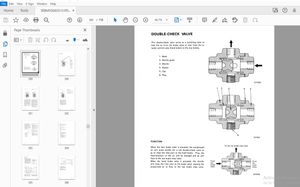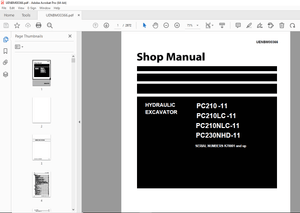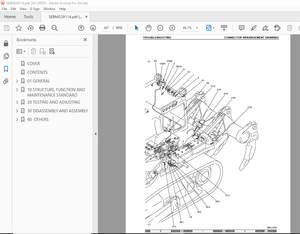$36
Manitowoc Grove RT9130E-2 Operator Manual – PDF DOWNLOAD
Manitowoc Grove RT9130E-2 Operator Manual – PDF DOWNLOAD
FILE DETAILS:
Manitowoc Grove RT9130E-2 Operator Manual – PDF DOWNLOAD
Language : English
Pages : 208
Downloadable : Yes
File Type : PDF
IMAGES PREVIEW OF THE MANUAL:


TABLE OF CONTENTS:
Manitowoc Grove RT9130E-2 Operator Manual – PDF DOWNLOAD
See end of this Manual for Alphabetical Index 7
SECTION 1 15
Introduction 15
General 15
Customer Support 15
New Owners 15
Safety Information 16
Noise/Vibration Test Results 16
Noise Level Test Results 16
Vibration Level Test Results 16
Serial Number Location 17
List Of Specifications 21
General 21
Dimensions 21
Capacities 21
Torque Converter 21
Transmission 21
Engine 21
Cummins QSL or (QSC) 21
Axles 21
Brakes 21
Wheels and Tires 21
Swing Gearbox 21
Boom 21
Swivel Assembly 21
Hydraulic Pumps 22
Pump #1 22
Pump #2 22
Pump #3 22
Pump #4 22
Hoists 22
Wire Rope (Hoist Cable) 25
General 25
Environmental Conditions 25
Dynamic Shock Loads 25
Lubrication 25
Precautions and Recommendations During Inspection or Replacement 25
Wire Rope Inspection (Running Ropes and Pendant Cables) 26
Keeping Records 26
Frequent Inspection 26
Periodic Inspection 27
Wire Rope Inspection/Replacement (All Wire Rope) 27
Seizing Wire Rope 27
Method 1 27
Method 2 28
Installing 35×7 Class Wire Rope 28
SECTION 2 31
Safety Information 31
Safety Messages 31
General 31
Safety Alert Symbol 32
Signal Words 32
General 32
Safety Decals 32
Accidents 32
Operator Information 32
Operator Qualifications 33
Operational Aids 34
Rated Capacity Limiter (RCL) Systems (If Equipped) 34
Anti-Two-Blocking Device 34
Working Area Limiter (If Equipped) 35
Crane Stability/Structural Strength 36
Load Charts 36
Work Site 36
Wind Forces 37
Wind Speeds 37
Determination of 3-second wind gust speed at boom tip height: 40
Size and Shape of the load: 40
Determining Wind Drag Coefficient (Cd) 41
Maximum Permissible Wind Speed 42
Example and Sample Calculations (metric) 44
Example 1: Crane Configuration: 44
Load example 1 1: 45
Load example 1 2: 45
Load example 1 3a: 45
Load example 1 3b: 45
Example and Sample Calculations (Non-metric) 48
Example 2: 48
Load example 2 1: 49
Load example 2 2: 49
Load example 2 3a: 49
Load example 2 3b: 49
Lifting Operations 50
Counterweight 51
Outrigger Lift Off 51
Multiple Crane Lifts 51
Tilt-Up Panel Lifting 51
Pile Driving and Extracting 52
Crane Equipment 52
Crane Inspection 52
Electrocution Hazard 53
Set-Up and Operation 54
Electrocution Hazard Devices 54
Electrical Contact 55
Special Operating Conditions and Equipment 55
Grounding the Crane 55
Personnel Handling 56
Environmental Protection 57
Maintenance 57
Service and Repairs 57
Lubrication 58
Tires 59
Hoist Rope 59
Synthetic Hoist Rope 59
Wire Rope 59
Sheaves 60
Batteries 61
Super Capacitor (If Equipped) 61
General Maintenance 61
Transporting the Crane 62
Travel Operation 62
Work Practices 63
Personal Considerations 63
Crane Access 63
Job Preparation 63
Working 64
Lifting 65
Hand Signals 66
Boom Extension 68
Parking and Securing 68
Shut-Down 68
Cold Weather Operation 69
Temperature Effects on Hook Blocks 69
Temperature Effects on Hydraulic Cylinders 69
Overload Inspection 70
Boom Inspection 72
Superstructure Inspection 74
Carrier Inspection 76
SECTION 3 79
Operating Controls and Procedures 79
Steering column 83
Drive Axle Selector Switch 84
Turn Signal Lever and Windshield Wiper/ Washer/Headlight /Horn Controls 84
Steering Column Tilt/Telescope Lever 84
Park Brake Control Switch 84
Headlights Switch 84
Drive Axle Selector Switch 84
Hazard Lights Switch 85
Engine Diagnostic and Engine Speed Control Switches 85
Engine Diagnostic/Speed Control Switch 85
Increment/Decrement Switch 85
Ignition Switch 85
Transmission Shift Lever 85
Cab Overhead Controls 86
Skylight Window Latch 86
Skylight Wiper and Wiper Motor 86
Skylight Sunscreen 86
Overhead Light 86
Cab Circulating Fan 86
Right Side Window Latch 86
Overhead Control Panel 87
Heater/Air Conditioner Fan Switch 87
Heater Control Switch 87
Air Conditioner Switch 87
Skylight Wiper Switch 87
Dimmer Switch 87
Work Lights Switch 87
Boom Lights Switch (Optional) 87
Crane Function Power Switch 87
Hoist Rotation Indicator Display 88
Exhaust System Cleaning Switch (Tier 4 Engines Only) 88
Boom Tele-1 / Tele-2 Select Switch & Indicator 88
Boom Manual/Auto Switch 88
Steering Column Indicator and Gauge Display 90
Swing Brake Engaged 91
Parking Brake Engaged 91
Light Malfunction 91
Emergency Stop 91
Hydraulic Oil High Temperature 91
Transmission Warning 91
Low Steer Pressure 91
Left Turn Signal Indicator 91
Low Brake Pressure 91
Electronic Module Control 91
Electronic System Diagnostic 91
LCD Display 92
Engine Stop 92
Engine Warning 92
Exhaust System Cleaning (Tier 4 Engines Only) 92
Right Turn Signal Indicator 93
Inhibit Cleaning 93
Diesel Exhaust Fluid (Tier 4F Engines Only) 93
High Exhaust System Temperature 93
Engine Wait to Start 93
Four-Wheel Drive Engaged 93
Interaxle Locked 93
Rear Wheels Not Centered Indicator 93
Engine Coolant Temperature Gauge 93
Fuel Gauge 93
Low Fuel Level 93
Battery Charge Indicator 94
Voltmeter 94
Tachometer 94
Control Seat Assembly – Single Axis 95
Main Hoist Control (Single Axis Option) 95
Boom Lift Control (Single Axis Option) 95
Boom Lift and Main Hoist Control Lever (Dual Axis Option — Not Shown) 95
Main Hoist Speed Selector Switch 95
Auxiliary Hoist Control (Single Axis Option) 96
Swing Control (Single Axis Option) 96
Swing and Telescope or Swing and Auxiliary Hoist Control Lever (Dual Axis Option—Not Shown) 96
Auxiliary Hoist Speed Selector Switch (Optional) 96
Rear Steer Switch 96
Swing Brake Control Switch 96
Axle Differential Lock Control Switch (Optional) 96
Cab Door Release 97
Seat Back Adjustment 97
A/C Heater, Climate Control 97
Seat Slide Lever 97
Seat Frame Slide Lever 97
Armrest Adjustment 97
Hoist Rotation Indicators (HRI) 97
HRI Display 97
Cab Tilt Switch 97
Luffing Jib Raise/Lower Switch (Optional) 98
Luffing Jib On/Off Switch (Optional) 98
Two-Speed Swing Switch 98
Armrest Switch (Not Shown) 98
Seat Switch (Not Shown) 98
Side Control Panel 98
Rated Capacity Limiter (RCL) and Work Area Definition System Control Panel 99
Rated Capacity Limiter (RCL) Bypass Switch 99
Emergency Stop Switch 99
Transmission Oil Temperature Gauge 99
Turntable Pin Swing Lock Control 99
12V Receptacle 99
Diagnostic Connector 99
Bubble Level Indicator 99
Hose Reel Brake Indicator 99
Boom Not Sync Indicator 99
Hoist Minimum Wrap Indicator (Optional, Standard w/CE) 100
Cold Weather Indicator (Optional) 100
Telescope Cylinder Charge Indicator (If Equipped) 100
Ambient Temperature Indicator (Optional) 100
Outrigger Control 100
Cab Outrigger Control 100
Extend/Retract Switch 100
Outrigger Selector Switches 100
Foot Pedal Controls 101
Swing Lock Pedal 101
Swing Brake Pedal 101
Telescope Control Foot Pedal 102
Service Brake Foot Pedal 102
Foot Throttle Pedal 102
Miscellaneous Controls and Indicators 103
Fuse Panel 103
Buzzer 103
Rated Capacity Limiter (RCL) Emergency Override Switch (Non-CE Certified Cranes) 103
Rated Capacity Limiter (RCL) Emergency Override Switch and Indicator (CE Certified Cranes) 104
Rated Capacity Limiter (RCL) Internal Light Bar (Optional—Not Shown) 104
Strobe Light or Beacon (Optional—Not Shown) 104
Backup Alarm (Not Shown) 104
Emergency Exit 104
Operating Procedures 105
Pre-Starting Checks 105
Fuel Supply 105
Engine Oil 105
Engine Coolant 105
Batteries 105
Signal and Running Lights 105
Foot and Parking Brakes 105
Daily Lubrication 105
Hydraulic Reservoir and Filter 105
Tires 105
Wire Rope 105
Hook Block 105
Air Cleaner 105
Air Intake Restriction Monitoring (AIRM) Communications System – Tier 4 Only 105
Cold Weather Operation 105
Component Coolant Heater 106
Radiator Shutters 107
Auxiliary Cab Heater 107
Battery Heater 107
Air Diverter 107
Super Capacitor 107
Operation Below -40°C (-40°F) 108
Crane Warm-up Procedures 108
Engine 108
Transmission 108
Hoist 109
Swing Drive and Turntable Bearing 109
Axles 109
Hydraulic Oil System 109
Engine Operation 109
Starting Procedure 110
Use the correct grade of oil for the prevailing temperature in the crankcase to prevent hard cranking Diesel fuel should have a cloud point of 6°C (10°F) less than the lowest expected temperature In case of emergency, white kerosene may be added 110
Battery Disconnect Switch 110
Cold Engine 110
Warm Engine 111
Allow the engine to warm up at least five minutes before applying a load Do not race the engine for a faster warm up 111
Idling the Engine 111
Racing the Engine 111
Shutdown Procedure 111
Crane Travel Operation 112
Traveling — General 112
Traveling — Towing/Pulling 113
Traveling — Being Towed/Pulled 113
Travel on Slopes 114
Traveling with Elevated Boom 114
Traveling with Jib and/or Inserts Erected 115
11 m (36 ft)/18 m (59 ft) Jib 115
18 m (59 ft) Jib Plus 8 m (26 ft) / 16 m (52 ft) Insert 115
Extended Travel 116
Traveling — Forward 116
Traveling — Reverse 117
Steering 117
Front Wheel Steering 117
Rear Wheel Steering 117
Four Wheel Steering 117
Crabbing 117
Four-Wheel Drive Operation 118
Differential Lock Operation (Optional) 118
General 118
Operation 119
Axle Oscillation Lockouts Operation 119
If the axle oscillation lockout valve is functioning properly, the crane will re-level itself; if the valve is not working properly, the crane will not re-level itself If the rear axle does not lock or unlock properly, evaluate the lockout system an 119
General Crane Operation 119
Pump Drive 119
Control Lever Operation 120
Preload Check 120
Using Your Load Chart 120
Proper Leveling of the Crane 121
Bubble Level Adjustment 121
Setting the Outriggers 121
Outrigger Monitoring System (OMS) (Optional) 122
Engaging the Mid-Extend Lock Pin 123
Stowing the Outriggers 123
Stowing the Mid-Extend Lock Pin 123
Swinging the Boom 123
Elevating and Lowering the Boom 124
Elevating the Boom 124
Lowering the Boom 124
Telescoping the Boom 124
Extending the Boom 124
Retracting the Boom 124
Lowering and Raising the Hoist Cable 125
Lowering the Cable 125
Raising the Cable 125
Hoist Speed Range Selection 125
Raising and Lowering the Hydraulic Jib 125
Raising the Hydraulic Jib 125
Lowering the Hydraulic Jib 126
Operational Aids 126
Rated Capacity Limiter (RCL) System 126
Control Lever Lockout System 127
Stowing and Parking 127
Unattended Crane 128
SECTION 4 129
Set-up and Installation 129
General 129
Installing Cable on the Hoist 129
Cable Reeving 130
Boom Cable Reeving 131
Dead-End Rigging/Wedge Sockets 131
Installing Wedge and Socket 131
Anti Two Block (A2B) Switch 138
Lock 138
Unlock 138
Before Operation 138
Cranes with Main Hoist Only 138
Machines with Main and Auxiliary Hoists 139
Counterweight Removal and Installation 140
Counterweight Stand Installation 140
Standard and Heavy Counterweight and Auxiliary Hoist Structure 140
Removal 140
Installation 143
Counterweight Stand Removal 144
Outrigger Box Removal and Installation 145
Bleed Valve Operation 145
Procedure 145
Removal 145
Installation 146
Removing and Installing the Swingaway Jib 147
Removal 147
Installation 148
Connecting and Disconnecting Hydraulic Boom Extension 153
Connecting 153
Establish a Hydraulic Connection Between the Boom Extension and the Main Boom 153
Establish an Electrical Connection Between the Lattice Extension and the Main Boom 153
Establish Electrical Connection Between Boom Extension and Anti-Two Block Switch 154
Disconnecting 154
Disconnect the Electrical Connection Between the Jib and the Main Boom 154
Disconnect the Hydraulic Connection Between the Jib and the Main Boom 154
Swingaway Mounting Adjustment 154
Jib—with Inserts 154
Identification 154
Serial Numbers On the 8 m (26 ft) Inserts 155
Slinging Points 155
Assembly of Jibs 156
Installing the 26 m (85 ft)/34 m (112 ft) Jib 156
Removing the 26 m (85 ft)/34 m (112 ft) Jib 157
Installing/Removing 8 m (26 ft) Inserts 157
Installing 8 m (26 ft) Inserts 157
Removing 8 m (26 ft) Inserts 158
Hydraulic Connection on the Boom Inserts 159
Connections on the 8 m (26 ft) Sections 159
Electrical Connection on the Boom Inserts 159
Connections on the 8 m (26 ft) Sections 159
Establishing Electrical Connections 160
For the 26 m (85 ft) Jib 160
For the 34 m (112 ft) Jib 160
Folding Out/In the Deflection Sheaves on the 8 m (26 ft) Sections 160
Folding Out Deflection Sheave 160
Folding In Deflection Sheave 160
Positioning/Removing Hoist Cable 160
Positioning the Hoist Cable 160
Removing the Hoist Cable 161
Setting Folding Swingaway Extension Offset 161
SECTION 5 163
Maintenance and Lubrication 163
General 163
Environmental Protection 163
Lubricants and Lubrication Intervals 163
Standard Lubricants 165
Arctic Lubricants and Conditions 166
Temperatures Below -9°C (15°F) 166
Cold Weather Package and Lubricants 166
Surface Protection for Cylinder Rods 169
Wire Rope Lubrication 169
Lubrication Points 170
CraneLUBE 170
Cummins Oil Registration List 170
Safety 170
Steering and Suspension 171
Axles 173
Drive Train 175
Drive Train (continued) 177
Turntable 179
Cab Tilt 181
Outriggers 183
Boom 185
Boom (continued) 188
Boom (continued) 190
Hoist 192
Hydraulic 194
Diesel Exhaust Fluid (DEF) 196
Instructions for Accessing Lubrication Points on Boom 198
Carwell® Rust Inhibitor 199
Protecting Cranes From Rusting 199
Cleaning Procedures 199
Inspection and Repair 200
Application 200
Areas of Application 200



